Contemporary Management Issues and Strategies for Adapting to the New Normal: A Case Study of ASDA
VerifiedAdded on 2023/06/17
|8
|2236
|431
AI Summary
This report discusses the impact of communication technology and information on workforce management, policies related to talent acquisition, learning and development, and change management process in relation to strategic objectives. It also provides recommendations for new initiatives that organizations should adopt to survive and thrive in the new normal.
Contribute Materials
Your contribution can guide someone’s learning journey. Share your
documents today.
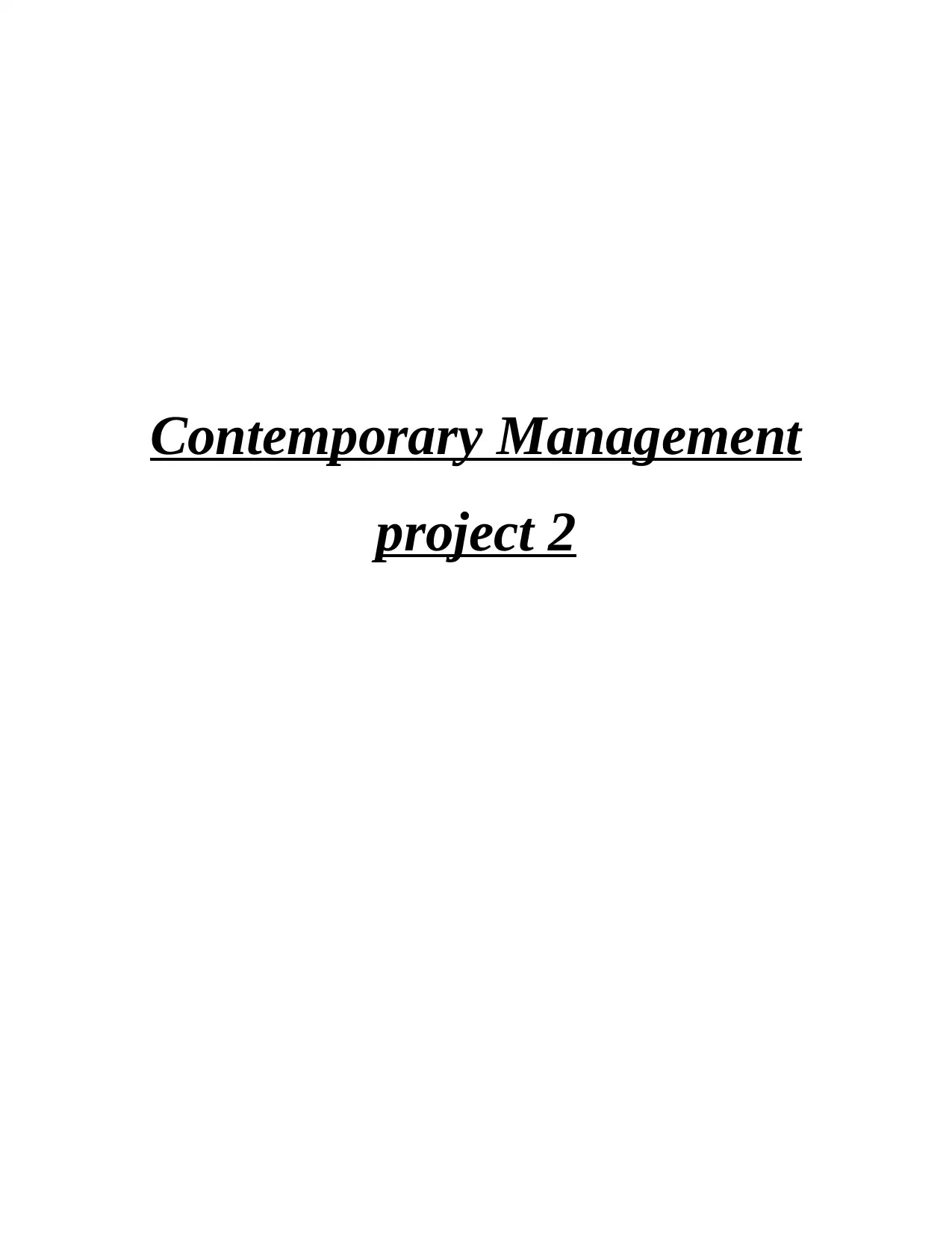
Contemporary Management
project 2
project 2
Secure Best Marks with AI Grader
Need help grading? Try our AI Grader for instant feedback on your assignments.
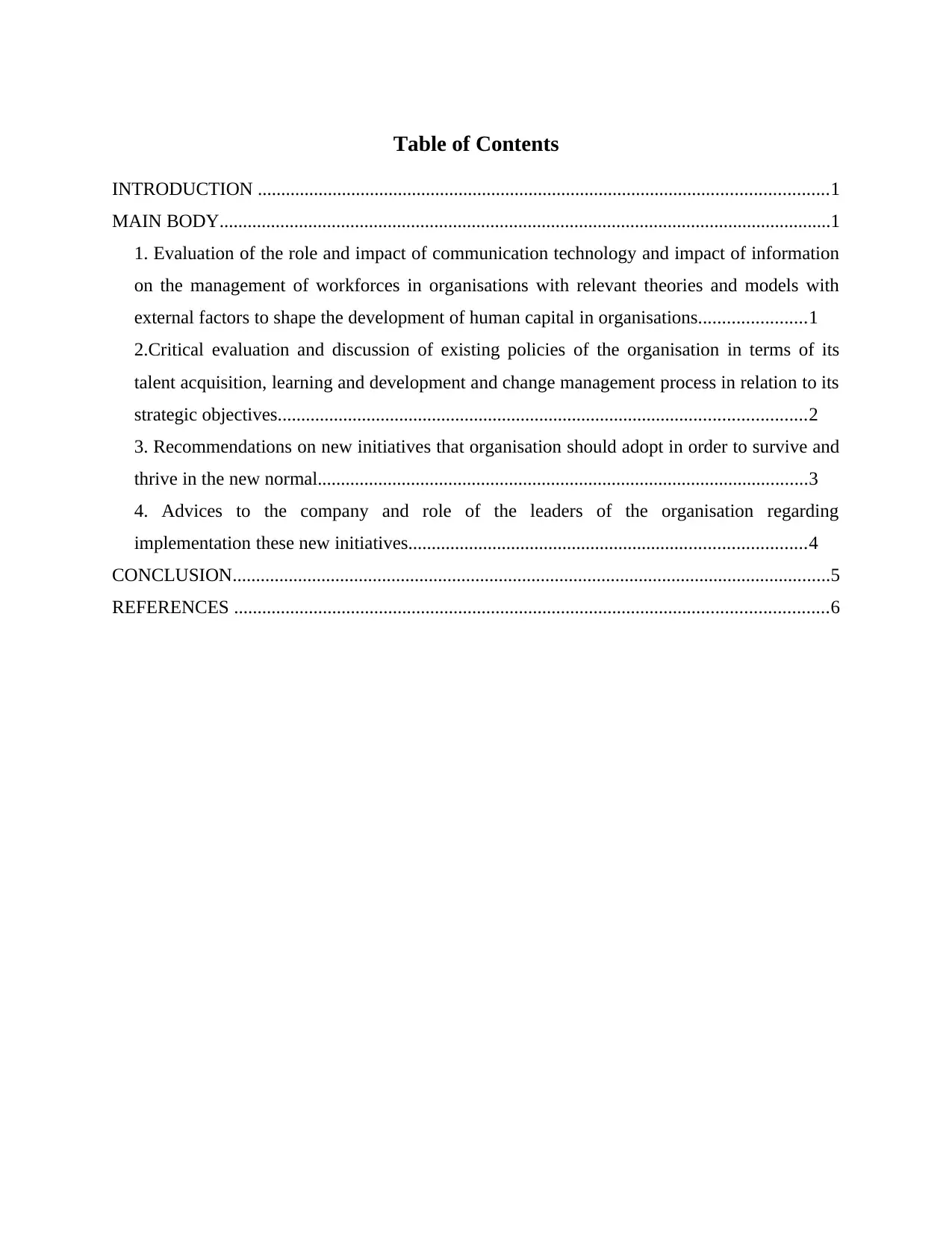
Table of Contents
INTRODUCTION ..........................................................................................................................1
MAIN BODY...................................................................................................................................1
1. Evaluation of the role and impact of communication technology and impact of information
on the management of workforces in organisations with relevant theories and models with
external factors to shape the development of human capital in organisations.......................1
2.Critical evaluation and discussion of existing policies of the organisation in terms of its
talent acquisition, learning and development and change management process in relation to its
strategic objectives.................................................................................................................2
3. Recommendations on new initiatives that organisation should adopt in order to survive and
thrive in the new normal.........................................................................................................3
4. Advices to the company and role of the leaders of the organisation regarding
implementation these new initiatives.....................................................................................4
CONCLUSION................................................................................................................................5
REFERENCES ...............................................................................................................................6
INTRODUCTION ..........................................................................................................................1
MAIN BODY...................................................................................................................................1
1. Evaluation of the role and impact of communication technology and impact of information
on the management of workforces in organisations with relevant theories and models with
external factors to shape the development of human capital in organisations.......................1
2.Critical evaluation and discussion of existing policies of the organisation in terms of its
talent acquisition, learning and development and change management process in relation to its
strategic objectives.................................................................................................................2
3. Recommendations on new initiatives that organisation should adopt in order to survive and
thrive in the new normal.........................................................................................................3
4. Advices to the company and role of the leaders of the organisation regarding
implementation these new initiatives.....................................................................................4
CONCLUSION................................................................................................................................5
REFERENCES ...............................................................................................................................6
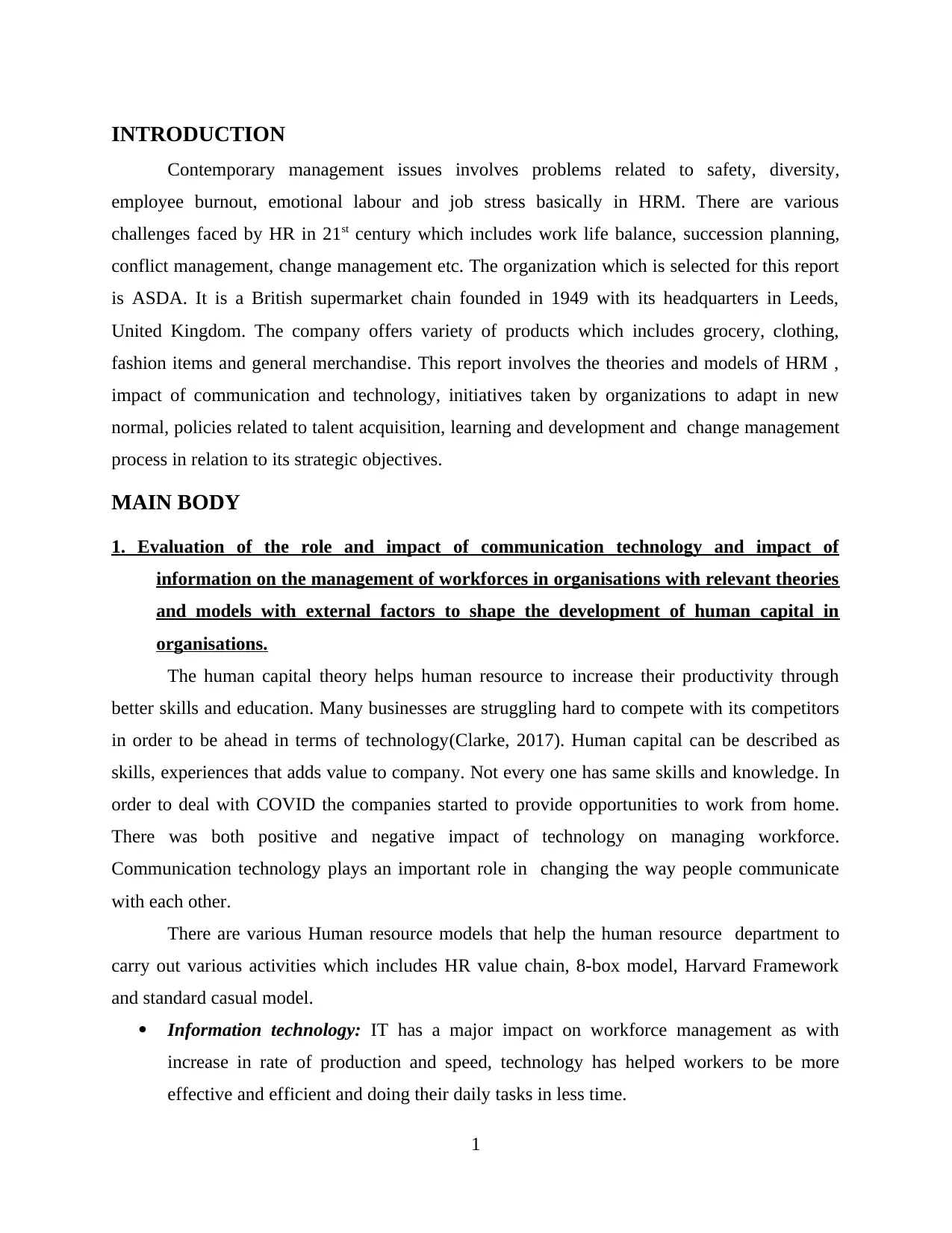
INTRODUCTION
Contemporary management issues involves problems related to safety, diversity,
employee burnout, emotional labour and job stress basically in HRM. There are various
challenges faced by HR in 21st century which includes work life balance, succession planning,
conflict management, change management etc. The organization which is selected for this report
is ASDA. It is a British supermarket chain founded in 1949 with its headquarters in Leeds,
United Kingdom. The company offers variety of products which includes grocery, clothing,
fashion items and general merchandise. This report involves the theories and models of HRM ,
impact of communication and technology, initiatives taken by organizations to adapt in new
normal, policies related to talent acquisition, learning and development and change management
process in relation to its strategic objectives.
MAIN BODY
1. Evaluation of the role and impact of communication technology and impact of
information on the management of workforces in organisations with relevant theories
and models with external factors to shape the development of human capital in
organisations.
The human capital theory helps human resource to increase their productivity through
better skills and education. Many businesses are struggling hard to compete with its competitors
in order to be ahead in terms of technology(Clarke, 2017). Human capital can be described as
skills, experiences that adds value to company. Not every one has same skills and knowledge. In
order to deal with COVID the companies started to provide opportunities to work from home.
There was both positive and negative impact of technology on managing workforce.
Communication technology plays an important role in changing the way people communicate
with each other.
There are various Human resource models that help the human resource department to
carry out various activities which includes HR value chain, 8-box model, Harvard Framework
and standard casual model.
Information technology: IT has a major impact on workforce management as with
increase in rate of production and speed, technology has helped workers to be more
effective and efficient and doing their daily tasks in less time.
1
Contemporary management issues involves problems related to safety, diversity,
employee burnout, emotional labour and job stress basically in HRM. There are various
challenges faced by HR in 21st century which includes work life balance, succession planning,
conflict management, change management etc. The organization which is selected for this report
is ASDA. It is a British supermarket chain founded in 1949 with its headquarters in Leeds,
United Kingdom. The company offers variety of products which includes grocery, clothing,
fashion items and general merchandise. This report involves the theories and models of HRM ,
impact of communication and technology, initiatives taken by organizations to adapt in new
normal, policies related to talent acquisition, learning and development and change management
process in relation to its strategic objectives.
MAIN BODY
1. Evaluation of the role and impact of communication technology and impact of
information on the management of workforces in organisations with relevant theories
and models with external factors to shape the development of human capital in
organisations.
The human capital theory helps human resource to increase their productivity through
better skills and education. Many businesses are struggling hard to compete with its competitors
in order to be ahead in terms of technology(Clarke, 2017). Human capital can be described as
skills, experiences that adds value to company. Not every one has same skills and knowledge. In
order to deal with COVID the companies started to provide opportunities to work from home.
There was both positive and negative impact of technology on managing workforce.
Communication technology plays an important role in changing the way people communicate
with each other.
There are various Human resource models that help the human resource department to
carry out various activities which includes HR value chain, 8-box model, Harvard Framework
and standard casual model.
Information technology: IT has a major impact on workforce management as with
increase in rate of production and speed, technology has helped workers to be more
effective and efficient and doing their daily tasks in less time.
1
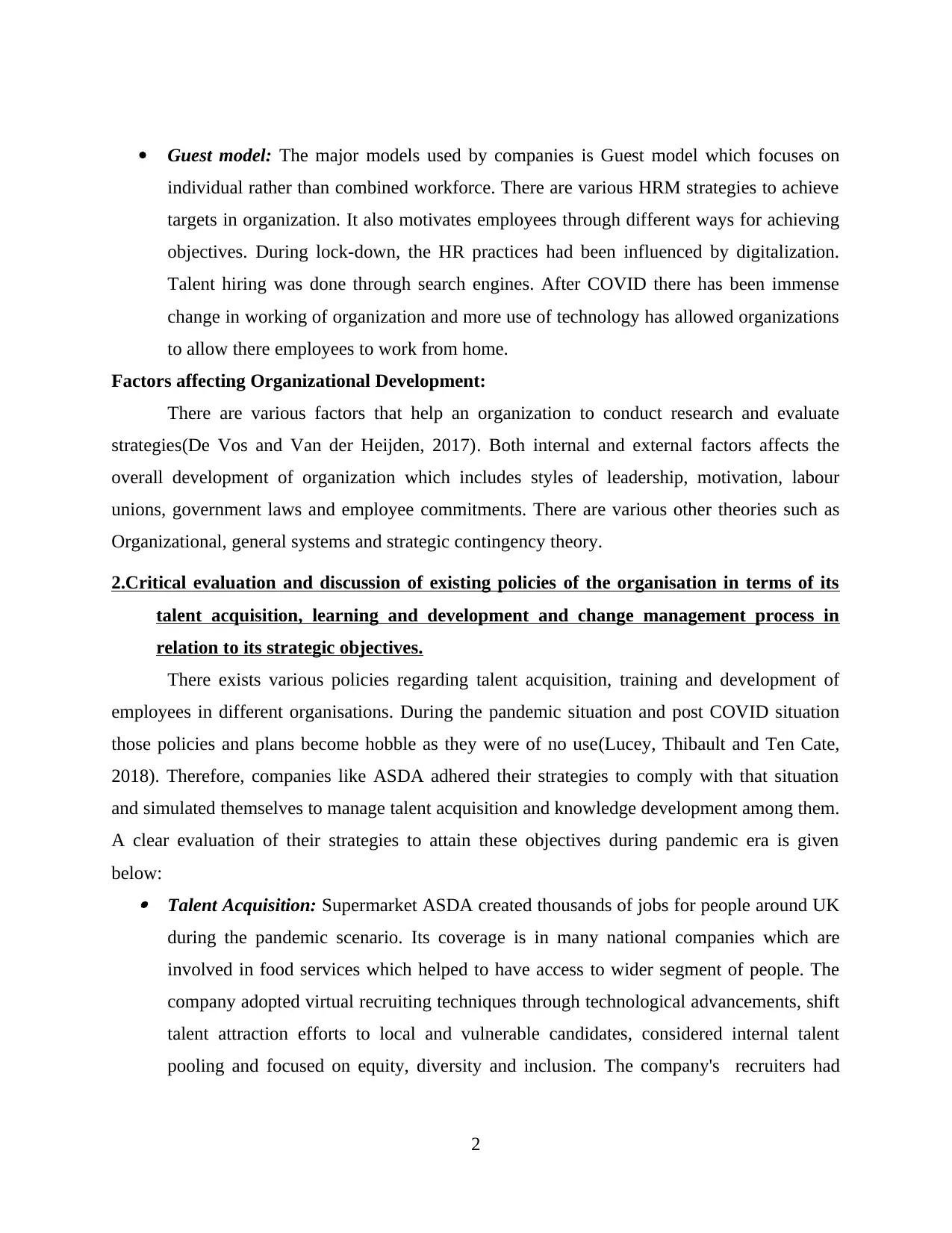
Guest model: The major models used by companies is Guest model which focuses on
individual rather than combined workforce. There are various HRM strategies to achieve
targets in organization. It also motivates employees through different ways for achieving
objectives. During lock-down, the HR practices had been influenced by digitalization.
Talent hiring was done through search engines. After COVID there has been immense
change in working of organization and more use of technology has allowed organizations
to allow there employees to work from home.
Factors affecting Organizational Development:
There are various factors that help an organization to conduct research and evaluate
strategies(De Vos and Van der Heijden, 2017). Both internal and external factors affects the
overall development of organization which includes styles of leadership, motivation, labour
unions, government laws and employee commitments. There are various other theories such as
Organizational, general systems and strategic contingency theory.
2.Critical evaluation and discussion of existing policies of the organisation in terms of its
talent acquisition, learning and development and change management process in
relation to its strategic objectives.
There exists various policies regarding talent acquisition, training and development of
employees in different organisations. During the pandemic situation and post COVID situation
those policies and plans become hobble as they were of no use(Lucey, Thibault and Ten Cate,
2018). Therefore, companies like ASDA adhered their strategies to comply with that situation
and simulated themselves to manage talent acquisition and knowledge development among them.
A clear evaluation of their strategies to attain these objectives during pandemic era is given
below: Talent Acquisition: Supermarket ASDA created thousands of jobs for people around UK
during the pandemic scenario. Its coverage is in many national companies which are
involved in food services which helped to have access to wider segment of people. The
company adopted virtual recruiting techniques through technological advancements, shift
talent attraction efforts to local and vulnerable candidates, considered internal talent
pooling and focused on equity, diversity and inclusion. The company's recruiters had
2
individual rather than combined workforce. There are various HRM strategies to achieve
targets in organization. It also motivates employees through different ways for achieving
objectives. During lock-down, the HR practices had been influenced by digitalization.
Talent hiring was done through search engines. After COVID there has been immense
change in working of organization and more use of technology has allowed organizations
to allow there employees to work from home.
Factors affecting Organizational Development:
There are various factors that help an organization to conduct research and evaluate
strategies(De Vos and Van der Heijden, 2017). Both internal and external factors affects the
overall development of organization which includes styles of leadership, motivation, labour
unions, government laws and employee commitments. There are various other theories such as
Organizational, general systems and strategic contingency theory.
2.Critical evaluation and discussion of existing policies of the organisation in terms of its
talent acquisition, learning and development and change management process in
relation to its strategic objectives.
There exists various policies regarding talent acquisition, training and development of
employees in different organisations. During the pandemic situation and post COVID situation
those policies and plans become hobble as they were of no use(Lucey, Thibault and Ten Cate,
2018). Therefore, companies like ASDA adhered their strategies to comply with that situation
and simulated themselves to manage talent acquisition and knowledge development among them.
A clear evaluation of their strategies to attain these objectives during pandemic era is given
below: Talent Acquisition: Supermarket ASDA created thousands of jobs for people around UK
during the pandemic scenario. Its coverage is in many national companies which are
involved in food services which helped to have access to wider segment of people. The
company adopted virtual recruiting techniques through technological advancements, shift
talent attraction efforts to local and vulnerable candidates, considered internal talent
pooling and focused on equity, diversity and inclusion. The company's recruiters had
2
Secure Best Marks with AI Grader
Need help grading? Try our AI Grader for instant feedback on your assignments.
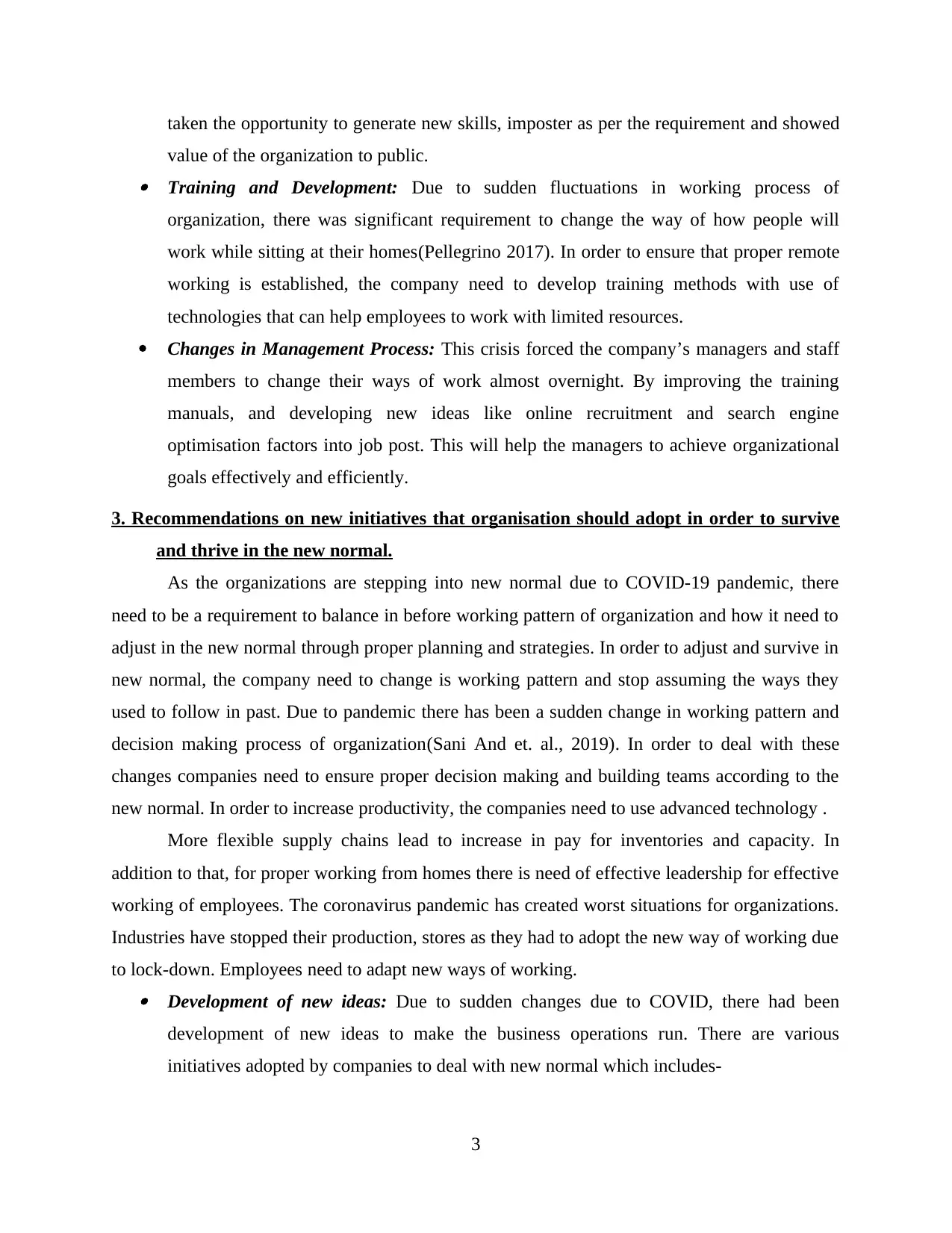
taken the opportunity to generate new skills, imposter as per the requirement and showed
value of the organization to public. Training and Development: Due to sudden fluctuations in working process of
organization, there was significant requirement to change the way of how people will
work while sitting at their homes(Pellegrino 2017). In order to ensure that proper remote
working is established, the company need to develop training methods with use of
technologies that can help employees to work with limited resources.
Changes in Management Process: This crisis forced the company’s managers and staff
members to change their ways of work almost overnight. By improving the training
manuals, and developing new ideas like online recruitment and search engine
optimisation factors into job post. This will help the managers to achieve organizational
goals effectively and efficiently.
3. Recommendations on new initiatives that organisation should adopt in order to survive
and thrive in the new normal.
As the organizations are stepping into new normal due to COVID-19 pandemic, there
need to be a requirement to balance in before working pattern of organization and how it need to
adjust in the new normal through proper planning and strategies. In order to adjust and survive in
new normal, the company need to change is working pattern and stop assuming the ways they
used to follow in past. Due to pandemic there has been a sudden change in working pattern and
decision making process of organization(Sani And et. al., 2019). In order to deal with these
changes companies need to ensure proper decision making and building teams according to the
new normal. In order to increase productivity, the companies need to use advanced technology .
More flexible supply chains lead to increase in pay for inventories and capacity. In
addition to that, for proper working from homes there is need of effective leadership for effective
working of employees. The coronavirus pandemic has created worst situations for organizations.
Industries have stopped their production, stores as they had to adopt the new way of working due
to lock-down. Employees need to adapt new ways of working. Development of new ideas: Due to sudden changes due to COVID, there had been
development of new ideas to make the business operations run. There are various
initiatives adopted by companies to deal with new normal which includes-
3
value of the organization to public. Training and Development: Due to sudden fluctuations in working process of
organization, there was significant requirement to change the way of how people will
work while sitting at their homes(Pellegrino 2017). In order to ensure that proper remote
working is established, the company need to develop training methods with use of
technologies that can help employees to work with limited resources.
Changes in Management Process: This crisis forced the company’s managers and staff
members to change their ways of work almost overnight. By improving the training
manuals, and developing new ideas like online recruitment and search engine
optimisation factors into job post. This will help the managers to achieve organizational
goals effectively and efficiently.
3. Recommendations on new initiatives that organisation should adopt in order to survive
and thrive in the new normal.
As the organizations are stepping into new normal due to COVID-19 pandemic, there
need to be a requirement to balance in before working pattern of organization and how it need to
adjust in the new normal through proper planning and strategies. In order to adjust and survive in
new normal, the company need to change is working pattern and stop assuming the ways they
used to follow in past. Due to pandemic there has been a sudden change in working pattern and
decision making process of organization(Sani And et. al., 2019). In order to deal with these
changes companies need to ensure proper decision making and building teams according to the
new normal. In order to increase productivity, the companies need to use advanced technology .
More flexible supply chains lead to increase in pay for inventories and capacity. In
addition to that, for proper working from homes there is need of effective leadership for effective
working of employees. The coronavirus pandemic has created worst situations for organizations.
Industries have stopped their production, stores as they had to adopt the new way of working due
to lock-down. Employees need to adapt new ways of working. Development of new ideas: Due to sudden changes due to COVID, there had been
development of new ideas to make the business operations run. There are various
initiatives adopted by companies to deal with new normal which includes-
3
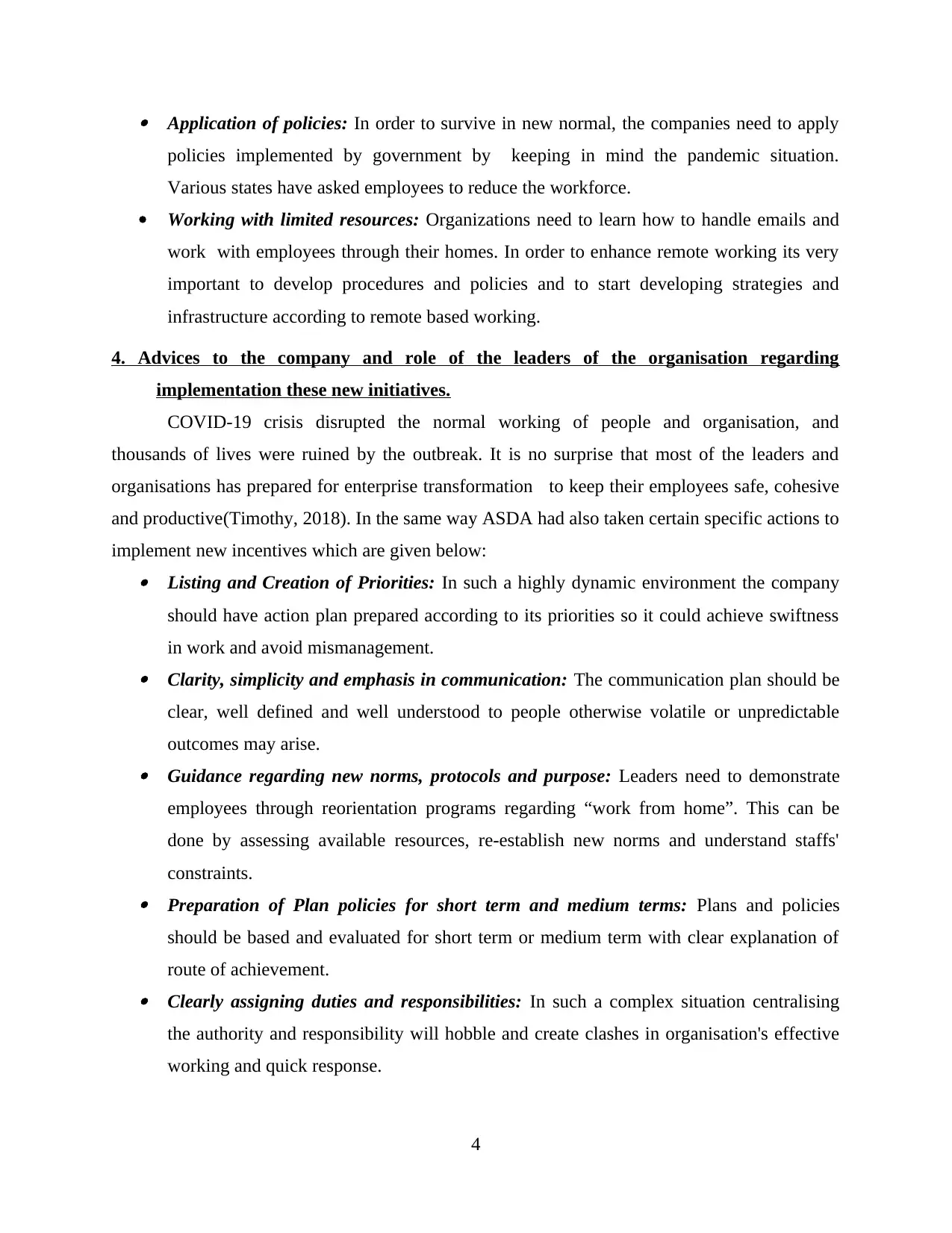
Application of policies: In order to survive in new normal, the companies need to apply
policies implemented by government by keeping in mind the pandemic situation.
Various states have asked employees to reduce the workforce.
Working with limited resources: Organizations need to learn how to handle emails and
work with employees through their homes. In order to enhance remote working its very
important to develop procedures and policies and to start developing strategies and
infrastructure according to remote based working.
4. Advices to the company and role of the leaders of the organisation regarding
implementation these new initiatives.
COVID-19 crisis disrupted the normal working of people and organisation, and
thousands of lives were ruined by the outbreak. It is no surprise that most of the leaders and
organisations has prepared for enterprise transformation to keep their employees safe, cohesive
and productive(Timothy, 2018). In the same way ASDA had also taken certain specific actions to
implement new incentives which are given below: Listing and Creation of Priorities: In such a highly dynamic environment the company
should have action plan prepared according to its priorities so it could achieve swiftness
in work and avoid mismanagement. Clarity, simplicity and emphasis in communication: The communication plan should be
clear, well defined and well understood to people otherwise volatile or unpredictable
outcomes may arise. Guidance regarding new norms, protocols and purpose: Leaders need to demonstrate
employees through reorientation programs regarding “work from home”. This can be
done by assessing available resources, re-establish new norms and understand staffs'
constraints. Preparation of Plan policies for short term and medium terms: Plans and policies
should be based and evaluated for short term or medium term with clear explanation of
route of achievement. Clearly assigning duties and responsibilities: In such a complex situation centralising
the authority and responsibility will hobble and create clashes in organisation's effective
working and quick response.
4
policies implemented by government by keeping in mind the pandemic situation.
Various states have asked employees to reduce the workforce.
Working with limited resources: Organizations need to learn how to handle emails and
work with employees through their homes. In order to enhance remote working its very
important to develop procedures and policies and to start developing strategies and
infrastructure according to remote based working.
4. Advices to the company and role of the leaders of the organisation regarding
implementation these new initiatives.
COVID-19 crisis disrupted the normal working of people and organisation, and
thousands of lives were ruined by the outbreak. It is no surprise that most of the leaders and
organisations has prepared for enterprise transformation to keep their employees safe, cohesive
and productive(Timothy, 2018). In the same way ASDA had also taken certain specific actions to
implement new incentives which are given below: Listing and Creation of Priorities: In such a highly dynamic environment the company
should have action plan prepared according to its priorities so it could achieve swiftness
in work and avoid mismanagement. Clarity, simplicity and emphasis in communication: The communication plan should be
clear, well defined and well understood to people otherwise volatile or unpredictable
outcomes may arise. Guidance regarding new norms, protocols and purpose: Leaders need to demonstrate
employees through reorientation programs regarding “work from home”. This can be
done by assessing available resources, re-establish new norms and understand staffs'
constraints. Preparation of Plan policies for short term and medium terms: Plans and policies
should be based and evaluated for short term or medium term with clear explanation of
route of achievement. Clearly assigning duties and responsibilities: In such a complex situation centralising
the authority and responsibility will hobble and create clashes in organisation's effective
working and quick response.
4
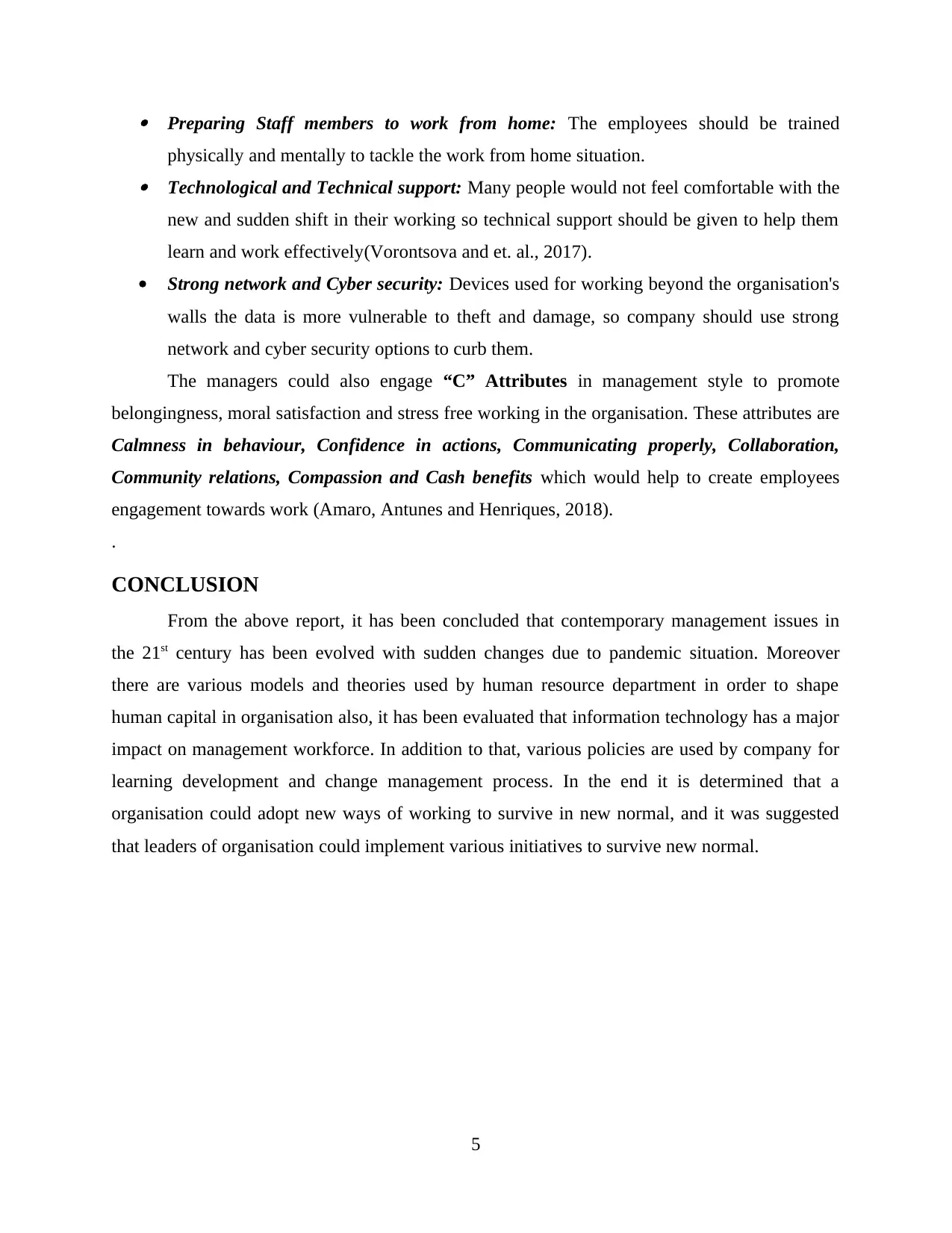
Preparing Staff members to work from home: The employees should be trained
physically and mentally to tackle the work from home situation. Technological and Technical support: Many people would not feel comfortable with the
new and sudden shift in their working so technical support should be given to help them
learn and work effectively(Vorontsova and et. al., 2017).
Strong network and Cyber security: Devices used for working beyond the organisation's
walls the data is more vulnerable to theft and damage, so company should use strong
network and cyber security options to curb them.
The managers could also engage “C” Attributes in management style to promote
belongingness, moral satisfaction and stress free working in the organisation. These attributes are
Calmness in behaviour, Confidence in actions, Communicating properly, Collaboration,
Community relations, Compassion and Cash benefits which would help to create employees
engagement towards work (Amaro, Antunes and Henriques, 2018).
.
CONCLUSION
From the above report, it has been concluded that contemporary management issues in
the 21st century has been evolved with sudden changes due to pandemic situation. Moreover
there are various models and theories used by human resource department in order to shape
human capital in organisation also, it has been evaluated that information technology has a major
impact on management workforce. In addition to that, various policies are used by company for
learning development and change management process. In the end it is determined that a
organisation could adopt new ways of working to survive in new normal, and it was suggested
that leaders of organisation could implement various initiatives to survive new normal.
5
physically and mentally to tackle the work from home situation. Technological and Technical support: Many people would not feel comfortable with the
new and sudden shift in their working so technical support should be given to help them
learn and work effectively(Vorontsova and et. al., 2017).
Strong network and Cyber security: Devices used for working beyond the organisation's
walls the data is more vulnerable to theft and damage, so company should use strong
network and cyber security options to curb them.
The managers could also engage “C” Attributes in management style to promote
belongingness, moral satisfaction and stress free working in the organisation. These attributes are
Calmness in behaviour, Confidence in actions, Communicating properly, Collaboration,
Community relations, Compassion and Cash benefits which would help to create employees
engagement towards work (Amaro, Antunes and Henriques, 2018).
.
CONCLUSION
From the above report, it has been concluded that contemporary management issues in
the 21st century has been evolved with sudden changes due to pandemic situation. Moreover
there are various models and theories used by human resource department in order to shape
human capital in organisation also, it has been evaluated that information technology has a major
impact on management workforce. In addition to that, various policies are used by company for
learning development and change management process. In the end it is determined that a
organisation could adopt new ways of working to survive in new normal, and it was suggested
that leaders of organisation could implement various initiatives to survive new normal.
5
Paraphrase This Document
Need a fresh take? Get an instant paraphrase of this document with our AI Paraphraser
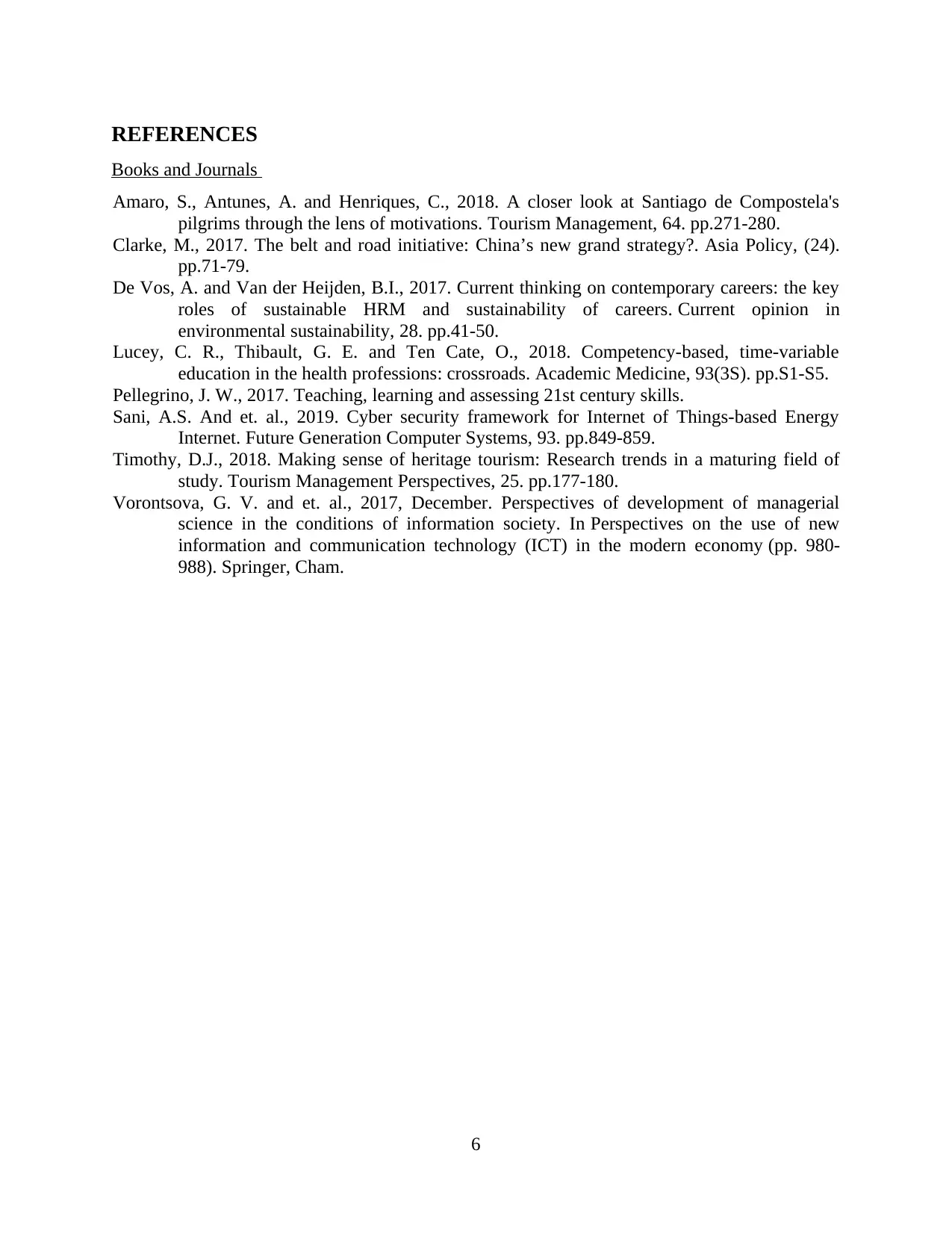
REFERENCES
Books and Journals
Amaro, S., Antunes, A. and Henriques, C., 2018. A closer look at Santiago de Compostela's
pilgrims through the lens of motivations. Tourism Management, 64. pp.271-280.
Clarke, M., 2017. The belt and road initiative: China’s new grand strategy?. Asia Policy, (24).
pp.71-79.
De Vos, A. and Van der Heijden, B.I., 2017. Current thinking on contemporary careers: the key
roles of sustainable HRM and sustainability of careers. Current opinion in
environmental sustainability, 28. pp.41-50.
Lucey, C. R., Thibault, G. E. and Ten Cate, O., 2018. Competency-based, time-variable
education in the health professions: crossroads. Academic Medicine, 93(3S). pp.S1-S5.
Pellegrino, J. W., 2017. Teaching, learning and assessing 21st century skills.
Sani, A.S. And et. al., 2019. Cyber security framework for Internet of Things-based Energy
Internet. Future Generation Computer Systems, 93. pp.849-859.
Timothy, D.J., 2018. Making sense of heritage tourism: Research trends in a maturing field of
study. Tourism Management Perspectives, 25. pp.177-180.
Vorontsova, G. V. and et. al., 2017, December. Perspectives of development of managerial
science in the conditions of information society. In Perspectives on the use of new
information and communication technology (ICT) in the modern economy (pp. 980-
988). Springer, Cham.
6
Books and Journals
Amaro, S., Antunes, A. and Henriques, C., 2018. A closer look at Santiago de Compostela's
pilgrims through the lens of motivations. Tourism Management, 64. pp.271-280.
Clarke, M., 2017. The belt and road initiative: China’s new grand strategy?. Asia Policy, (24).
pp.71-79.
De Vos, A. and Van der Heijden, B.I., 2017. Current thinking on contemporary careers: the key
roles of sustainable HRM and sustainability of careers. Current opinion in
environmental sustainability, 28. pp.41-50.
Lucey, C. R., Thibault, G. E. and Ten Cate, O., 2018. Competency-based, time-variable
education in the health professions: crossroads. Academic Medicine, 93(3S). pp.S1-S5.
Pellegrino, J. W., 2017. Teaching, learning and assessing 21st century skills.
Sani, A.S. And et. al., 2019. Cyber security framework for Internet of Things-based Energy
Internet. Future Generation Computer Systems, 93. pp.849-859.
Timothy, D.J., 2018. Making sense of heritage tourism: Research trends in a maturing field of
study. Tourism Management Perspectives, 25. pp.177-180.
Vorontsova, G. V. and et. al., 2017, December. Perspectives of development of managerial
science in the conditions of information society. In Perspectives on the use of new
information and communication technology (ICT) in the modern economy (pp. 980-
988). Springer, Cham.
6
1 out of 8
Related Documents
Your All-in-One AI-Powered Toolkit for Academic Success.
+13062052269
info@desklib.com
Available 24*7 on WhatsApp / Email
![[object Object]](/_next/static/media/star-bottom.7253800d.svg)
Unlock your academic potential
© 2024 | Zucol Services PVT LTD | All rights reserved.
